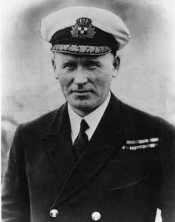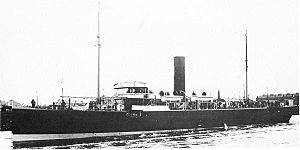Ronald Stuart facts for kids
Quick facts for kids
Ronald Niel Stuart
|
|
|---|---|
 |
|
| Born | 26 August 1886 Toxteth, Liverpool |
| Died | 8 February 1954 (aged 67) Charing, Kent |
| Buried |
Charing Cemetery
|
| Service/ |
Royal Naval Reserve Merchant Navy |
| Years of service | 1914–1951 |
| Rank | Captain and Commodore |
| Unit | Royal Naval Reserve |
| Commands held | Royal Navy: Q-ship HMS Tamarisk Merchant Navy: SS Brandon, SS Minnedosa, SS Duchess of York, RMS Empress of Britain |
| Battles/wars | World War I
|
| Awards | Victoria Cross Distinguished Service Order Royal Navy Reserve Decoration Mentioned in Despatches Croix de Guerre (France) Navy Cross (United States) |
Ronald Niel Stuart (born August 26, 1886 – died February 8, 1954) was a brave British sailor. He became a Commodore in the British Merchant Navy and a Captain in the Royal Navy. He was known for his amazing service at sea for over 35 years.
During World War I, Stuart earned many top awards. These included the Victoria Cross (VC), the Distinguished Service Order (DSO), the French Croix de Guerre, and the United States' Navy Cross. He received these for his daring missions against German submarines in the Atlantic Ocean.
What's special about his Victoria Cross is that his crew voted for him to receive it! This was very unusual. The navy leaders couldn't decide who deserved the honor after a tough battle. Later in his career, he commanded a famous ship called the RMS Empress of Britain. He also managed a big shipping office in London. Ronald Stuart retired in 1951 and passed away three years later.
Contents
Early Life and Sea Adventures
Ronald Niel Stuart was born in Liverpool, England, in 1886. His parents, Neil Stuart and Mary Harrison, came from families who knew a lot about the sea. His dad was from Prince Edward Island in Canada, and his mom was from Australia. They moved to Liverpool, where Ronald was the youngest of six children. His father worked at the docks and owned a tea shop.
Ronald was described as a strong, blonde, blue-eyed man with a serious look. He went to Shaw Street College. But after his father died, he had to leave school and work as a clerk. He really disliked this job and Liverpool. So, in 1902, he decided to become a sailor. He started an apprenticeship with a shipping company and learned his trade on a sailing ship called Kirkhill.
His early sea career was full of challenges. In 1905, the Kirkhill crashed near the Falkland Islands. Ronald survived and returned to England. He was sent to another ship, but it was also wrecked by a storm near Florida. Despite these tough starts, he kept going. He eventually earned his sailor's qualifications. He then got a job as a junior officer with the Allan Line, traveling all over the world. In 1910, the Allan Line became part of the Canadian Pacific Line, and he continued working for them.
World War I Hero
When World War I began, Ronald Stuart joined the Royal Naval Reserve as an officer. He first served on an old destroyer, HMS Opossum, in Plymouth. This ship did boring harbor patrols. Stuart wanted more action. He kept asking to be transferred, even to the army! But his requests were always turned down.
The Secret Q-Ships
In 1916, Stuart finally got a transfer. He became the first officer on a special ship called a Q-ship. These were merchant ships that looked normal but had hidden weapons. The navy secretly commanded them with a Royal Navy crew. When a German submarine attacked, the Q-ship would pretend to be badly damaged. A "panic party" of sailors would even get into lifeboats, acting scared. This would trick the submarine into coming closer. Once the enemy was near enough, the Q-ship would reveal its hidden guns and attack!
Stuart's experience from merchant shipping was very helpful. He made sure his Q-ship, known as Q5 or HMS Farnborough, was well-maintained and ready. The captain, Gordon Campbell, was very impressed with Stuart.
Their first year on the Q-ship was frustrating. They hadn't sunk any submarines. In February 1917, Captain Campbell decided they needed to be torpedoed on purpose to get a submarine close enough. On February 17, off Southern Ireland, the Farnborough was hit by a torpedo. Campbell didn't try to avoid it. The ship was damaged, but the crew was ready. The "panic party" acted their part perfectly.
The German submarine U-83 came within 10 yards of the "sinking" ship. Suddenly, the Farnborough's hidden guns opened fire! The first shot hit the German captain, Bruno Hoppe. The U-boat was quickly destroyed. Eight German sailors escaped, but only two were rescued.
The Farnborough was also sinking. Captain Campbell sent a message: "Q5 slowly sinking respectfully wishes you goodbye." Nearby destroyers arrived to tow the ship. During the night, a depth charge exploded by accident. Campbell ordered the remaining 12 men into a lifeboat. He found Stuart had stayed on board to make sure his captain got off safely. The Farnborough was eventually beached and couldn't return to sea. Campbell received the Victoria Cross. Stuart and another officer, Len Loveless, received the Distinguished Service Order.
A Brave Rescue and a Special Award
After the Farnborough action, Stuart helped choose other ships to become Q-ships. He then returned to sea on a new Q-ship called HMS Pargust. This ship was heavily armed with guns, torpedoes, and depth charges. On June 7, 1917, off the coast of Ireland, the Pargust was hit by a torpedo from an unseen German submarine. The damage was huge. One gun port was almost blown open, but a quick-thinking sailor, William Williams, held it closed.
The German submarine UC-29 stayed 400 yards away, watching the "panic" evacuation. The officer in charge of the lifeboats, Lieutenant Francis Hereford, realized the submarine was following him. So, he ordered his men to row back towards the ship. This tricked the submarine commander into thinking the crew was trying to get back on board. He came closer, surfacing just 50 yards away.
This was the moment the hidden gun crews had waited for! They fired at the U-boat, hitting its conning tower. The submarine tried to escape but was hit again and exploded, breaking in two. Captain Rosenow and 22 of his crew died. Two survivors were rescued.
The damaged Pargust was towed to port. The Admiralty couldn't decide who among the crew deserved the Victoria Cross. Everyone had been equally brave. So, for the first time, they decided that one officer and one enlisted man would get the award after a vote by the crew. Ronald Stuart and William Williams were chosen! Fourteen other crew members also received medals.
Because Q-ship operations were secret, Stuart's and Williams's Victoria Crosses were announced without details. The full story wasn't told until after the war ended in 1918. Stuart was the first Anglo-Canadian to receive the Victoria Cross. King George V presented the medal to him at Buckingham Palace on July 23, 1917.
Commanding HMS Tamarisk
After receiving the Victoria Cross, Stuart was promoted to lieutenant commander. He was given his own command: HMS Tamarisk, a small ship disguised as a Q-ship.
On October 15, 1917, Stuart and the Tamarisk helped rescue the United States Navy destroyer USS Cassin. The Cassin had been torpedoed by U-61 in bad weather. It had lost its entire back section and was in danger of sinking. In the dark and high seas, the Tamarisk found the damaged ship and managed to pass a tow line. Twice the line broke, and twice it was reconnected. The next morning, other ships arrived, and together they saved the Cassin and its crew. Ten years later, the US Navy gave Stuart the Navy Cross for his part in this rescue. This was a rare honor for a sailor from another country.
The rest of the war was quieter for Stuart. After the war, in 1919, he was recognized for his service in the Q-ship operations. The French government also gave him the Croix de Guerre. In the same year, he married Evelyn, and they had three sons and two daughters.
Leading Big Ships
After the war, Stuart returned to Canadian Pacific, the shipping company. In 1927, he got his first command, the steam freighter SS Brandon. He was soon promoted to staff captain on the liner RMS Empress of Australia.
Just a year later, he became full captain of the 15,000-ton liner SS Minnedosa. This ship carried immigrants to Canada. In 1929, he took command of his biggest ship yet, the 20,000-ton ocean liner SS Duchess of York. He commanded her for five years, sailing from Liverpool to Canada.
In 1929, he received the Decoration for Officers of the Royal Naval Reserve (RD) for his long service. In 1935, he became a full Naval Reserve Captain. He stayed connected with the Royal Naval Reserve throughout his life. He even became a part-time naval assistant to King George VI during World War II. A special rule allowed him to fly the Blue Ensign flag from any ship he commanded.
In 1931, while he was commanding the Duchess of York, his wife passed away. This sad event changed Stuart. He never took time off work again and left his children to be cared for by his four sisters in England. In 1934, he took on his most important role at sea. He became the Commodore of the CPS fleet and commanded the huge 42,000-ton liner RMS Empress of Britain on its transatlantic route.
After three years commanding the Empress, Stuart moved to a desk job in Montreal, managing the company's assets. In 1937, he became the general manager of Canadian Pacific's London office. He held this job for 13 years, even through the tough times of World War II when London's docks were heavily bombed. Two of his sons also served in the war and were recognized for their bravery fighting German submarines.
Retirement
Ronald Stuart retired in 1951. He moved to his sisters' cottage in Charing, Kent. He spent his days reading, walking, and going to the cinema. He was known for loudly reacting to parts of movies he didn't like! He passed away at the cottage on February 8, 1954, at age 67. He was buried in Charing Cemetery.
His gravestone was later replaced with a standard white Commonwealth War Grave headstone. After his death, a street called 'Stuart Close' was named after him. His medals were given to the National Maritime Museum, where they are now on display for everyone to see.



